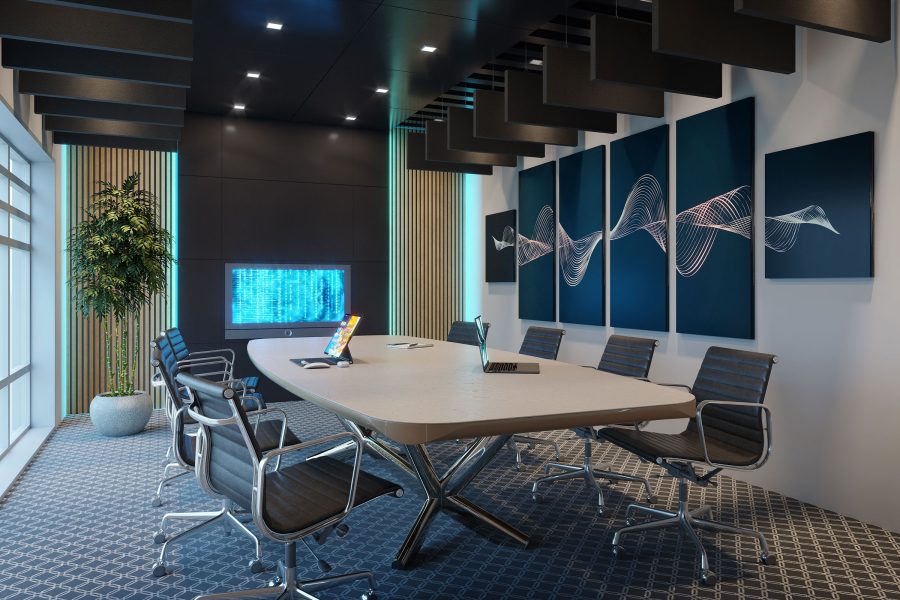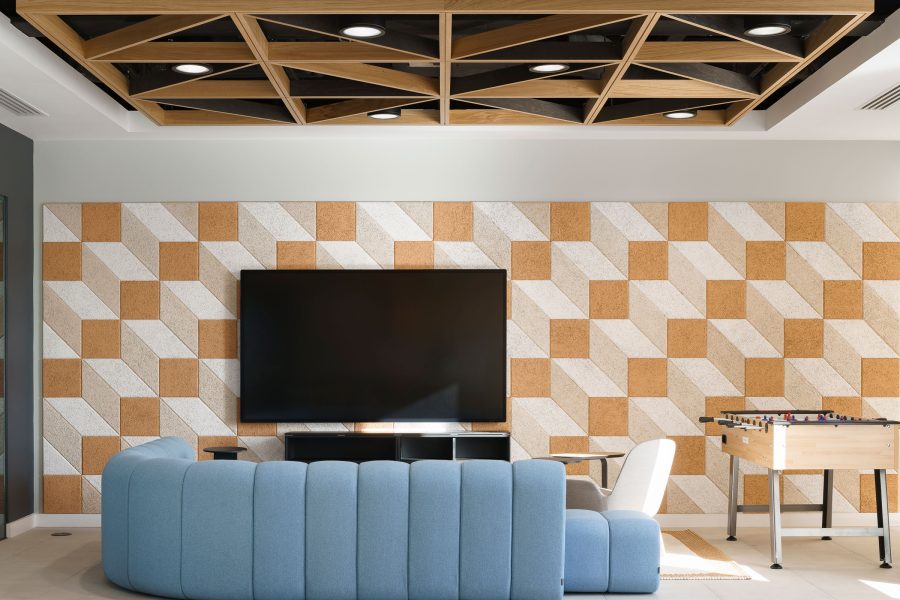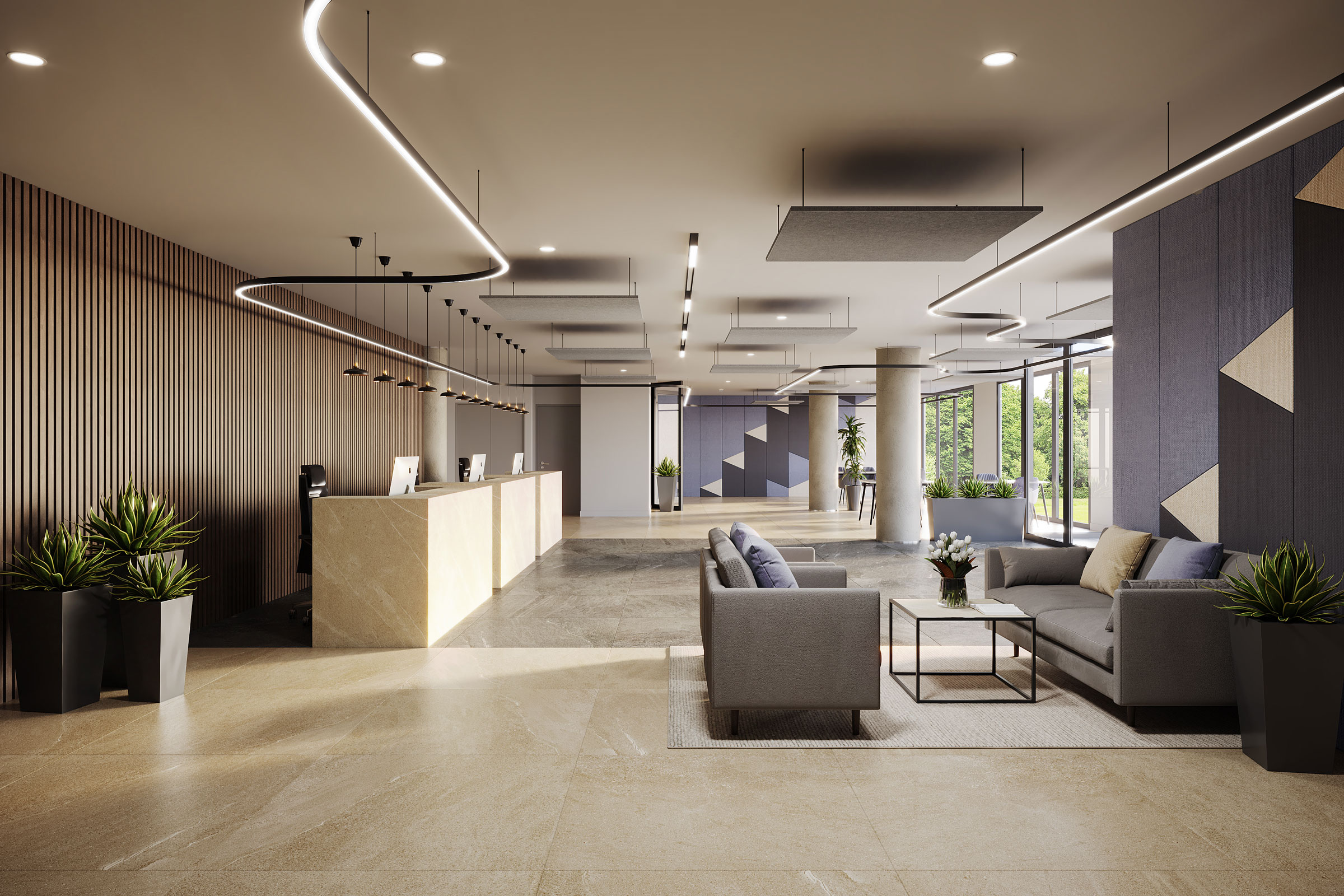Story at a glance:
- Acoustics haven’t always been at the forefront of building design, but industry experts now realize sound is not secondary, and there’s an expectation for acoustics to be an integral part of any design.
- Leaders like Primacoustic are listening to market trends and responding with an array of acoustic solutions that optimize the balance between performance, aesthetics, and environmental awareness.
- In a culture of wellness and sustainability, acoustic innovations include an endless selection of bio-based and recycled content solutions that help designers achieve green building certifications.
We’ve all been there—in the office on an important call, desperately trying to drown out the workspace cacophony so we can hear the person on the other end.
“People don’t necessarily understand the physics behind acoustics because you can’t see them, but everyone knows bad acoustics,” says Rob Cooke, managing director of Primacoustic, a top acoustic solutions company for more than 20 years.
While acoustics have not always been at the forefront of design conversations, modern spaces are considering sound in innovative ways.
A Holistic Approach

Primacoustic’s EcoScapes collection consists of wall panels, ceiling clouds, and slat walls made from PET plastic from recycled water and soda bottles. Photo courtesy of Primacoustic
Today expectations are high—acoustic solutions must perform well, fit modern aesthetics, and ideally be environmentally friendly. Wood has long been a popular material for its warmth and apparent absorptive properties, but alternatives like PET (polyethylene terephthalate) plastic have proven to be the better option.
That’s what Primacoustic realized when it tested PET and discovered it worked quite well acoustically. The company created EcoScapes—a collection of wall panels, ceiling clouds, and slat walls made from PET plastic that comes from recycled water and soda bottles. EcoScapes panels don’t compromise on sound absorption performance and are also highly customizable; they can be cut into nearly any shape and size and printed with colors, prints, patterns, and logos with custom manufacturing in Colorado.
“PET lends itself very nicely to print—any pattern that can be done in nature can be duplicated,” Cooke says, calling to mind the most popular natural elements being incorporated in modern designs—marble, granite, concrete, and of course, wood.
Sustainability Meets Style

Photo courtesy of Primacoustic
Brands are striving to meet market needs with acoustic products using recycled content and bio-based materials, low-carbon options, recycled PET panels, wood pulp panels, paper pulp panels, and mycelium-based acoustic panels.
“We’re seeing a trend in terms of acoustics and how far you can push innovation, and sustainability is a huge element. These brands are helping designers achieve certain sustainability criteria,” says Emanuela Caffrey, a senior interior designer at Perkins&Will in Dublin.
Caffrey says there’s been a lot of change in workplace design, and it’s all very exciting. “The pandemic reiterated how we cannot get too comfortable, that we have to constantly develop and evolve our solutions and embrace the fact that the nature of work is forever changing. There will never be a one-size-fits-all solution.”
Whether retrofitting existing buildings, renovating expanding businesses, or working on new projects, sound experts have had to pay attention to marketplace trends and user expectations, too.
Sound is important—and acoustics always matter.
But while more and more companies seek social, collaborative, and open office designs, many of those designs also boast aesthetic finishes in granite, marble, concrete, and glass. While beautiful, these layouts often create noise. And all those shiny modern finishes exacerbate—rather than absorb—sound reverberations.
“Open plan workspaces offer so many benefits, not just for collaboration, but for people’s well-being, for driving innovation and productivity, for driving work culture and social interactions—those water cooler moments,” Caffrey says. But issues like noise and distractions, privacy, and sound transmission continue to be common concerns.
Taking sound into consideration as a measure of building wellness is a recent revelation—acoustics weren’t even included in WELL’s original core standards. But the people spoke. Employees couldn’t stand being in workspaces because of the noise. People were realizing the effect noise has—on chronic stress, on productivity, on end users’ overall mental health and well-being. Companies were suddenly competing for employees based on how comfortable the workspace was.
“Sound is important—and acoustics always matter,” Cooke says. “It’s our mission to educate the experts charged with designing spaces so that they understand sound and can make sure it’s considered in every design. All we need is a few people to understand acoustics for everyone to benefit—so nobody has to put up with bad acoustics.”
Acoustics in Action

Perkins&Will designed a global FinTech headquarters in Dublin to include an array of acoustic products, including wall panels for sound absorption and aesthetics. Photo by Donal Murphy
It’s a highly complex process to incorporate proper acoustic solutions into building designs when every wall, ceiling, piece of furniture, fixture, and even services can be taken into consideration for sound treatment.
“Our key consideration is understanding our clients—the various end user groups and how they’ll work differently from each other—then designing holistic spaces that support the various activities. We take an activity-based planning approach,” Caffrey says of Perkins&Will.
Caffrey and her team found themselves drawing on an array of acoustic products and solutions in their recent completion of a global FinTech headquarters in Dublin. Within this open office project, a number of acoustic wall panels achieve sound absorption and serve as an aesthetic feature within the space, creating visual interest with pops of color and pattern. Semi-open slatted screens, rather than fully enclosed dividing partitions or walls, created a break in the open space to interrupt reverberation and sound transmission.
“Even though it may not seem like an acoustic solution at first glance, the more surfaces you have breaking up a wide, open plan space, the better it is for breaking up sound. It’s also a visual block to create a sense of privacy and serves as an aesthetic focal point as well,” Caffrey says.
Perkins&Will designed support spaces in such a way that they were broken up by cellular spaces that reduced the extent of sound travel and each of those blocks had private offices, phone booths, and quiet rooms where people could take calls or focus uninterrupted. Locally made acoustic rafts above desk banks and acoustic panels and ceiling baffles were utilized to address absorption.
In the canteen, glazed folding walls allowed for multi-function utilization, connecting wider social spaces or allowing an area to be enclosed to create acoustic privacy.
Acoustic pendants in certain open collaboration zones were yet another feature that added a focal point, provided lighting, and helped absorb sound.
“An acoustic finish can have so many functions and different elements. It can address privacy, it can bring biophilia and sustainability, it can address wellness. Some of the products and innovations we’re seeing address that multi-need very well,” Caffrey says.

